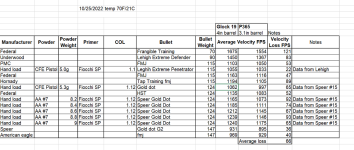So I went and shot a bunch of stuff over the chronograph today. I changed the way I am keeping my data and wanted good data for my individual guns and was curious to see the differences in barrel length. Hope you find this interesting and or helpful.
Note, The listed velocity from speer for the #7 load was 1180fps at 9.0g, however I met that velocity at 8.4g. I will be using 8.4g as it should be duplicating the proper pressure as it created the same velocity. I did experience some primer flattening and cratering at 8.8 and 9.0g and velocities were above listed. I called speer and they seemed to thing i was due to using different brand brass and primers than listed in the manual. it was intermittent and seemed to very with head stamp. Also my first time using fiocchi primers, not sure if they are softer than average.
Almost forgot Chronograph was set out at about 9ft. 5 rounds per test group. I considered including SD/ES, but its already a bit busy for my taste.

Note, The listed velocity from speer for the #7 load was 1180fps at 9.0g, however I met that velocity at 8.4g. I will be using 8.4g as it should be duplicating the proper pressure as it created the same velocity. I did experience some primer flattening and cratering at 8.8 and 9.0g and velocities were above listed. I called speer and they seemed to thing i was due to using different brand brass and primers than listed in the manual. it was intermittent and seemed to very with head stamp. Also my first time using fiocchi primers, not sure if they are softer than average.
Almost forgot Chronograph was set out at about 9ft. 5 rounds per test group. I considered including SD/ES, but its already a bit busy for my taste.
Attachments
Last edited:

